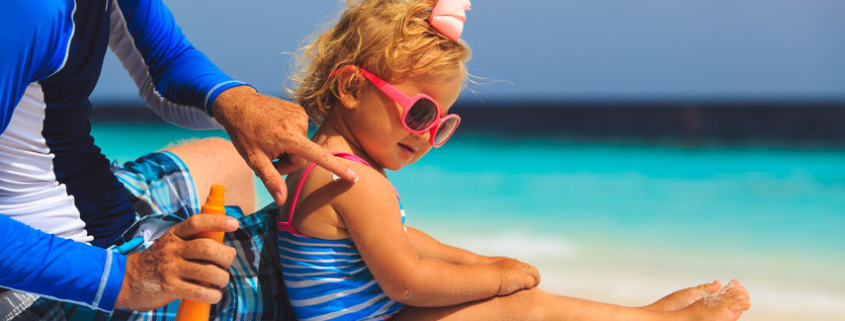Fun in the Sun: Adequate sun protection for our Children and Teenagers
By Dr. Elizabeth Colvin
Summer is all about fun in the sun and pool time but we have to be aware of the intense exposure to sun in Arizona that can be dangerous for our little ones. More than 50% of our total lifetime sun exposure occurs before the age of 20 so it is important to implement sun protection and provide education to your children as early as possible. However, it can seem overwhelming with hundreds of different sunscreens filling our store aisles and constant new information regarding sun protection, so this article aims to provide some helpful answers.
Adequate sun protection for children requires three approaches:
1. Firstly, avoidance of sun when the UV rays are the most intense
2. Secondly, provide physical protection from the sun
3. And lastly, use lots and lots of sunscreen
Let’s tackle these individually …
The best form of sun protection simply is accomplished by staying out of the sun during the periods of most intense UV radiation which from 10 am to 2 pm. For children < 6 months old, the AAP recommends ideally no direct sun exposure. This can be hard to do but it is important to find shade, use an umbrella, or place an infant in a stroller canopy to get out of the sun. With such little shade in Arizona, this likely means staying indoors as much as possible during this part of the day. For those times when we need to venture into the sun, this is when physical protection and sunscreen is a must. Physical protection means just what is says – dress your children in light weight protective clothing with long sleeves and long pants. Recommend using long sleeve swim shirts on top of bathing suits, wearing wide brimmed hats to protect the head, neck and face, and sunglasses to protect the eyes. Looks for sunglasses that provide at least 99% UV protection. Use clothing with a tight weave for ultimate UV protection. Use of sunscreen prior to going out into the sun is crucial in preventing sunburns, skin cancer and premature aging. However with all the different types of sunscreen these days it can be very confusing to know which one is the best for your child.
Remember these words:
– Broad spectrum.
– At least SPF 30.
– Water resistant.
Sunscreen that is broad spectrum blocks both UVA and UVB rays. UVA rays cause aging, UVB rays cause sunburns. SPF stands for the Sun Protection Factor and a SPF of 30 helps block about 97% of the UV rays! There is currently no known benefit of using SPF higher than 50. Water resistant forms of sunscreen can provide additional protection with swimming and sweating and are recommended for everyone. Recommend sunscreen for all children > 6 months old. Apply everywhere!
People most often miss their:
– Hands.
– Ears.
– Nose.
– Tops of feet.
For children < 6 months old, may use small amounts on sun exposed skin. Sunscreen with zinc oxide or titanium dioxide are usually easier on a baby’s sensitive skin. Apply 30 minutes prior to going out in the sun, again on arrival and then every 2 hours.
When to reapply?
– After swimming.
– Sweating.
– Drying off.
– Re-apply every 2 hours.
Lotions are recommended more than sprays because it can more effectively be applied to children, but ultimately the kind of sunscreen you choose is your personal choice.
Store sunscreen:
– In a cool, dry place.
– Store in cooler (feels good when it’s extra hot outside) or your bag if at park, beach or pool.
– Look for its expiration date. If it is expired, throw it out! If it has no expiration date, it typically retains its originally strength for 3 years per the FDA.
What if all these measures fail and SUN BURN results?
– Treat with cool compresses or cool baths.
– Gently rub skin with aloe vera or calamine lotion (I like to keep it in the fridge so it’s cool).
– Take motrin/tylenol for pain.
– Rehydrate your child with water or electrolyte beverage to replace fluids lost.
– For sunburns with blistering, pain or fever, see your pediatrician.
These are the most important tips to protect your little ones from the sun. For further information you may also look to the American Academy of Dermatology website www.aad.org and the American Academy of Pediatric website for parenting resources. healthychildren.org.
Our Pediatric Care Team at NOAH know how dangerous the #sun can be on your child’s little bodies. Check out a few of our recommended #tips that will help you ensure your child does not burn while #playingoutside. We are here to help you create and manage your #healthy #lifestyle habits. Need help setting or sticking to your goals? Call 480-882-4545 today or request an appointment! #Sunscreen #Pediatrics




